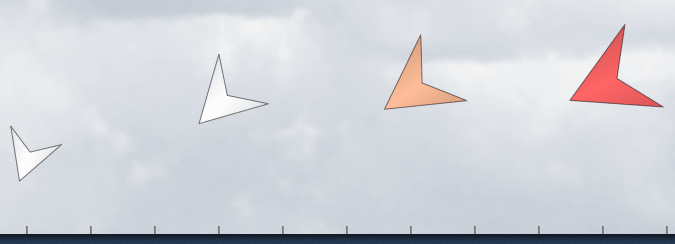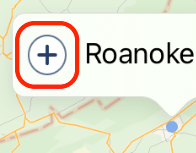Please check the frequently asked questions below and contact us if your question isn't covered or if you'd like to send feedback.
• Weather • Locations • Subscriptions • Widgets • Shortcuts •
"Feels Like" temperature

A "feels like" label is displayed if the difference from the regular temperature is at least 3 degrees Fahrenheit (~1.5 °C).
If you prefer, you can set the middle readout at the top of the screen to always show the "feels like" temperature. (By default it shows humidity. Tap it to change.)
Probability of sun, clouds, rain, and snow
The amount of space taken up by each weather type represents how likely each is to occur.

At the left end of the example here, you would expect to see direct sun (top) about 20% of the time, clouds with no precipitation (middle) about 60% of the time, and snow falling (bottom) about 20% of the time. As you move towards the right, you would expect a little more sun and a transition from snow to rain (if any precipitation falls at all).
The distance from the cloud line to the baseline of the graph represents the predicted cloud cover percentage. In the unusual case that the chance of rain is higher than the cloud coverage, it means storms are moving through the area quickly enough that the probability of rain falling over the course of an hour is more than the percentage of sky actually covered by clouds.
Remember, probabilities like these are designed to be accurate over the long term. For example, if the forecast is a 50% chance of rain, it might rain that whole time or it might not rain at all — or anywhere in between — but over many time periods with that particular forecast, on average you can expect rain 50% of the time.
Amount of rain and snow

The exact number of inches (or mm) expected per hour is shown in the legend.

Slushy snow is much denser than powdery snow, so forecasted snow amounts and meltwater amounts don't always move in lock-step. For example, as the snow transitions from slushy to powdery, the rate of snow accumulation could increase even as the meltwater equivalent decreases.
Wind

Windsocks are colored orange if the forecast has sustained winds above 30 mph (48 km/h) or gusts above 45 mph (72 km/h).
Windsocks are colored red (and in most cases, government warnings are issued) if sustained winds are above 39 mph (63 km/h) or gusts are above 57 mph (92 km/h).
Wind direction arrows

Arrow wind indicators are displayed on the timeline every 3 hours regardless of wind strength.
UV Index
UV indices measure the amount of harmful ultraviolet radiation from the sun that is expected to reach the earth's surface. The US EPA has an overview of how to interpret UV Index levels from low (1) to extreme (11+).

Rainbows?!
Weather Strip displays a rainbow across any time period where our proprietary algorithm determines there is a reasonably high chance that rainbows may be visible in the sky.
Choose forecast locations


Long-press anywhere on the map to

Save locations for easier switching
In most cases, locations are saved automatically when you view a forecast.

Forecast providers
If you have a premium subscription in the United States, two forecast providers are available. (Update your preference any time in app settings.) Foreca is used for all forecasts outside of the US.
Forecast update frequency
Weather Strip uses the most recent available forecast to predict the current weather conditions and the full week ahead. The app checks regularly for updates.
The age of your forecast depends on when it was last updated by the provider. Foreca updates its forecasts at least once per hour. In the US, NOAA usually issues new forecasts every 6 to 12 hours, depending on location and weather variability.
The current forecast age is displayed in the lower left corner (or a "✓" when the forecast is less than 5 hours old). Tap the label to see the full details and loading status.
Purchases on multiple devices
To access a purchase or upgrade you made on a different device, go to app settings (button in the lower-right of the main screen), tap "Subscription", then tap the "Restore Purchases" link.
Both devices must be signed in to the same Apple ID, or if you have a Family Premium subscription, all devices must be signed in to Apple IDs that are in the same Apple Family Sharing group.
Changing your subscription
You can change your subscription at any time from app settings (tap the button in the lower-right of the main screen, then tap "Subscription"). If you upgrade to a higher-priced subscription, it will start immediately and you will get a refund for any remaining time on your previous subscription. If you downgrade, it will take effect when your previous subscription expires.
Cancellations and Refunds
All purchases are managed by Apple. To stop your subscription from auto-renewing in the future, follow Apple's instructions for cancelling your subscription. If you regret your purchase and want to lose access to your subscription immediately, follow Apple's instructions for requesting a refund.
Widget basics
See Apple's guide for adding and editing widgets. Be aware that adding widgets to a home screen changes its layout and takes time to undo. It's helpful to experiment first on an empty home screen page.
Widget blank or "Requires premium subscription"
Widgets require a premium subscription to help cover the cost of extra data usage. If the widget displays a "Requires premium subscription" message — or in some cases if the widget shows an empty bubble — it means you are subscribed to the basic (US only) plan. To upgrade, tap to open the main app, tap the settings button in the lower right, then tap Subscription.
Widget styles
Show/hide the legend
Tap the left side of the main timeline to switch between expanded and minimized legends.
Quickly return to "now"
Tap the left end of the weekly view (the strip below the main timeline) to quickly scroll back to the beginning of the forecast, which represents the present moment in time.
Reloading the forecast
Weather Strip automatically reloads the forecast any time an updated version is expected. If an error occurs (such as no internet connection), you can manually reload the forecast by tapping the "!" in the lower left corner and then tapping "Reload".
Sign up to be notified about significant updates (you can unsubscribe at any time):
Connect on Twitter: @WeatherStripApp or @RobinStewart
Email the developer:
I welcome your feedback and read all correspondence, but I don't always have time to respond individually.
